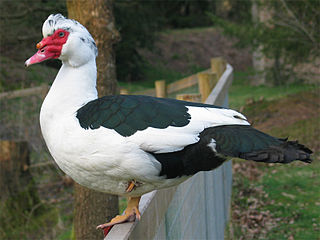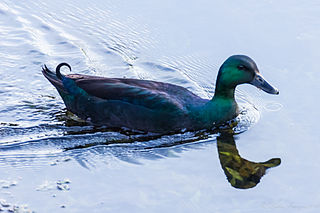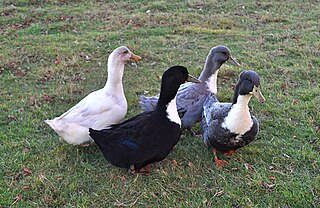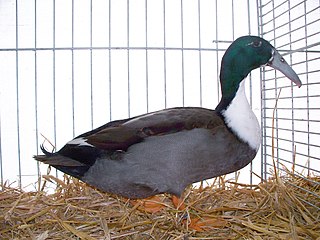
Poultry are domesticated birds kept by humans for the purpose of harvesting useful animal products such as meat, eggs or feathers. The practice of raising poultry is known as poultry farming. These birds are most typically members of the superorder Galloanserae (fowl), especially the order Galliformes. The term also includes waterfowls of the family Anatidae but does not include wild birds hunted for food known as game or quarry.

The greylag goose or graylag goose is a species of large goose in the waterfowl family Anatidae and the type species of the genus Anser. It has mottled and barred grey and white plumage and an orange beak and pink legs. A large bird, it measures between 74 and 91 centimetres in length, with an average weight of 3.3 kilograms. Its distribution is widespread, with birds from the north of its range in Europe and Asia often migrating southwards to spend the winter in warmer places, although many population are resident, even in the north. It is the ancestor of most breeds of domestic goose, having been domesticated at least as early as 1360 BCE. The genus name and specific epithet are from anser, the Latin for "goose".

The common eider, also called St. Cuthbert's duck or Cuddy's duck, is a large sea-duck that is distributed over the northern coasts of Europe, North America and eastern Siberia. It breeds in Arctic and some northern temperate regions, but winters somewhat farther south in temperate zones, when it can form large flocks on coastal waters. It can fly at speeds up to 113 km/h (70 mph).

The Muscovy duck is a duck native to the Americas, from the Rio Grande Valley of Texas and Mexico south to Argentina and Uruguay. Feral Muscovy ducks are found in New Zealand, Australia, and in Central and Eastern Europe. Small wild and feral breeding populations have also established themselves in the United States, particularly in Florida, Louisiana, Massachusetts, the Big Island of Hawaii, as well as in many other parts of North America, including southern Canada.

The swan goose is a large goose with a natural breeding range in inland Mongolia, Northeast China, and the Russian Far East. It is migratory and winters mainly in central and eastern China. Vagrant birds are encountered in Japan and Korea, and more rarely in Kazakhstan, Laos, coastal Siberia, Taiwan, Thailand and Uzbekistan.

The domestic duck is a subspecies of mallard that has been domesticated and raised for meat and eggs. A few are kept for show, as pets, or for their ornamental value. Almost all varieties of domesticated ducks, apart from the domestic Muscovy duck, are descended from the mallard, which was domesticated in China around 2000 BC.

The Pekin or White Pekin is an American breed of domestic duck, raised primarily for meat. It derives from birds brought to the United States from China in the nineteenth century, and is now bred in many parts of the world. It is often known as the American Pekin to distinguish it from the German Pekin, a distinct and separate breed which derives from the same Chinese stock but has different breeding. Many of these ducks were reared on Long Island, New York, in the late nineteenth and early twentieth centuries, from which the breed derived its name Long Island Duck.

A domestic goose is a goose that humans have domesticated and kept for their meat, eggs, or down feathers. Domestic geese have been derived through selective breeding from the wild greylag goose and swan goose.

Indian Runners are a breed of Anas platyrhynchos domesticus, the domestic duck. They stand erect like penguins and, rather than waddling, they run. The females usually lay about 300 to 350 eggs a year or more, depending whether they are from exhibition or utility strains. They were bred on the Indonesian islands of Lombok, Java and Bali where they were 'walked' to market and sold as egg-layers or for meat. These ducks do not fly and only rarely form nests and incubate their own eggs. They run or walk, often dropping their eggs wherever they happen to be. Duck-breeders need to house their birds overnight or be vigilant in picking up the eggs to prevent them from being taken by other animals.

The Cayuga is an American breed of domestic duck. It was introduced to the Finger Lakes region of New York State in about 1840, and is named for the Cayuga people of that area. Until the last years of the nineteenth century it was the principal duck reared for meat in the United States. In the twenty-first century it is kept mainly for ornament. The plumage is black with iridescent beetle-green lights.

The Swedish Blue or Blue Swedish is a Swedish breed of domestic duck. It originated in the former dominion of Swedish Pomerania – now in north-west Poland and north-east Germany – and is documented there from 1835. It is closely similar to the Pomeranian Duck from the same general area, differing mainly in its white primary feathers.

The Magpie is a British breed of domestic duck. It has distinctive black and white markings reminiscent of the European magpie, and is a good layer of large eggs.

The Silver Appleyard is a British breed of domestic duck. It was bred in the first half of the twentieth century by Reginald Appleyard, with the aim of creating a dual-purpose breed that would provide both a good quantity of meat and plenty of eggs.

The Ringamålako is an endangered Swedish breed of dairy cattle. It is named for the village of Ringamåla in the southern Swedish county of Blekinge, and is found primarily in southern Sweden. It is similar to the type of Swedish Red-and-White cattle of the 1940s, and is considered a valuable genetic resource.

The Hook Bill or Dutch Hookbill is a breed of domestic duck characterised by an unusual down-curved beak. It is an ancient breed, and has been documented since the seventeenth century. Speculation that it originated in Asia, or is related to the Indian Runner, is apparently unsubstantiated.

The Saxony duck is a German breed of domestic duck. It was bred in Saxony in the 1930s, but because of the Second World War was recognised only in 1957.

The German Pekin, German: Deutsche Pekingente, is a European breed of domestic duck. It is commonly called simply Pekin or White Pekin. It is a different breed from the American Pekin, which is also commonly known by the same names. It was bred in Europe from birds originating in China and Japan and is distributed in many European countries.

The Swedish Yellow duck or just Swedish Yellow is a medium-sized Swedish breed of domestic duck only verified to exist in their homeland.
The Silver Bantam is a small-sized British breed of domestic duck developed by Reginald Appleyard.


















